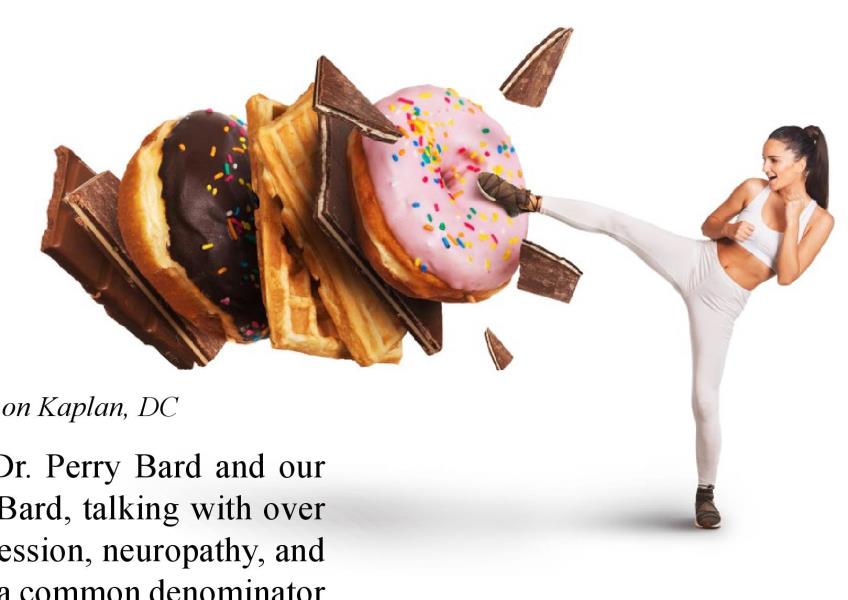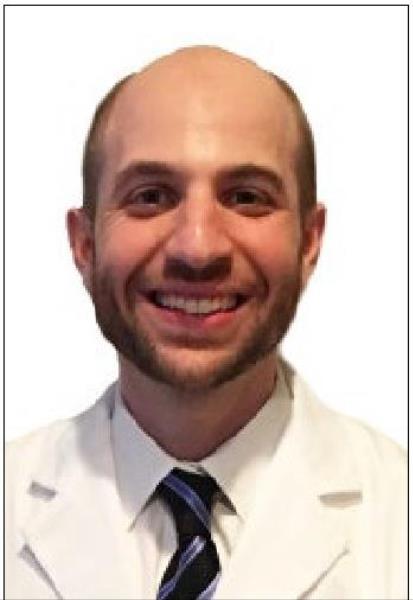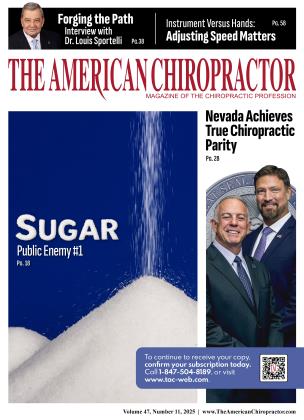
I TRAVELED AROUND THE COUNTRY with Dr. Perry Bard and our sons, Dr. Jason Kaplan and Dr. Devin Bard, talking with over 250 doctors in 46 states about decompression, neuropathy, and knee problems. We noticed that there is a common denominator with nutrition regarding the healing of all of those areas.
Neuropathy is strongly associated with diabetes, which can be the result of an overabundance of sugar, causing insulin resistance. We also found that sugar is associated with degenerative joint disease. So in this month’s article, I’m going to take you on a bit of a journey to Sugar City.
Sugar City is a place where so many of us have lived or visited regularly. The all-too-typical American breakfast consists of coffee washing down Danish pastries, cereal, or doughnuts, which are a form of white bread. We start our day off with foods that are denatured, overprocessed, oversalted, oversweetened, overconcentrated, overcooked, and denuded of all natural vitamins and minerals. Imagine attacking your cells with toxins the moment you wake up.
Despite all the concern over “lifestyle” disorders, such as heart disease, there is evidence that few of us watch what we eat. A Lewis Poll conducted for Prevention magazine revealed that 42% of those surveyed try hard to limit high-cholesterol foods, down from 46% the previous year. Only 54% try to avoid fat, compared to 56% the previous year, while only 59% (down from 63%) attempt to make sure they get enough vitamins and minerals. As Thomas Duybdahl of Prevention noted, “People know more about nutrition now than ever, but they are not acting on what they know.”
The frustration here lies in the nearsightedness of every facet of the health fraternity. Statistics show our concern for fats and cholesterol, but the sugar problem remains intellectually ignored. As we have decreased our fat consumption, we have increased our sugar consumption (as have our children).
Sugar is a prime culprit of poor health. It lowers our discipline, weakens our tissue, and is toxic to our brains. Over time, it will slowly and silently alter your blood chemistry, resulting in continued cravings for sugar or refined carbohydrates. Sugar is the real “silent killer.”
The little boy who hears “if you are good, you can have a cookie,” will learn to reward himself when he becomes a big boy. “I worked hard today, so I deserve a drink.” I’ve yet to see a candy bar wrapper that reads, “This substance may be hazardous to your health,” but there is overwhelming evidence that such a warning would be entirely appropriate.
According to Alexander G. Schauss of Washington State University, children consume, on average, about 274 pounds of sweeteners per year. According to the National Eating Trends Report, the average American consumes 200 snack foods per year.
Not yet convinced? Consider the following:
• $3.9 billion is spent annually on packaged store-bought cookies.
• Over 100 million M&Ms are produced each day.
• More than $8 billion worth of potato chips, pretzels, coin chips and tortilla chips, are consumed annually.
Snack foods are high in sugars, refined carbohydrates, and fat, forming a triumvirate of power that destroys our willpower, saps our strength, and leads us down the path to obesity and disease. Excess sugar eventually affects every organ in the body. Initially, it is stored in the liver in the form of glucose (glycogen), but when the liver is filled to capacity, excess glycogen is returned to the blood in the form of fatty acids.
Those are taken to every part of the body and stored in the most inactive areas first, followed by active organs, such as the heart and kidneys. The whole body is affected by their organs’ reduced ability, and an abnormal blood sugar level is created.
Refined sugar lacks natural minerals. Our parasympathetic nervous system is affected, and organs governed by it become inactive or paralyzed. The circulatory and lymphatic systems are inundated, and the qualities of red corpuscles start to change. An overabundance of white cells occurs, and the creation of tissues becomes slower.
About 20 years ago, Nancy Appleton, PhD, began researching how sugar destroys our health. Over the years, the list has continuously expanded and now includes 141 points. Here’s a small sample (find the list on her blog at Nancy -Appleton.com):
• Sugar feeds cancer cells and has been connected with the development of cancer of the breast, ovaries, prostate, rectum, pancreas, lung, gallbladder, and stomach.
A no-sugar diet is a healthy cell diet. Sugar is a prime culprit of poor health. You will lose energy, weaken your cells, and add unwanted pounds. Sugar is the real silent killer.”
• Sugar can increase fasting levels of glucose and cause reactive hypoglycemia.
• Sugar can cause many problems with the gastrointestinal tract, including an acidic digestive tract, indigestion, malabsorption in patients with functional bowel disease, increased risk of Crohn’s disease, and ulcerative colitis.
• Sugar can interfere with absorption of protein.
• Sugar can cause food allergies.
• Sugar contributes to obesity.
Sugar adversely affects our cells, and not all sugar is created alike. White table sugar (sucrose) is composed of glucose and fructose. Glucose is an important nutrient in our bodies and is healthy as long as it’s consumed in moderation. Fructose is a different story.
Fructose is found primarily in fruits, vegetables, and sweeteners, such as sugar and high-fructose corn syrup (HFCS). A recent USDA report found that the average American eats 152 pounds of sugar each year, including almost 64 pounds of HFCS.
Unlike glucose, which is rapidly absorbed into the bloodstream and taken up by the cells, fructose is shunted directly to the liver, where it is converted to fat. Excess fructose consumption causes a condition called nonalcoholic fatty liver disease (NAFLD), which is directly linked to both diabetes and obesity.
A 2009 study showed that shifting 25% of dietary calories from glucose to fructose caused a fourfold increase in abdominal fat. Abdominal fat is an independent predictor of insulin sensitivity, impaired glucose tolerance, high blood pressure, high cholesterol, high triglycerides, and several other metabolic diseases.
Everyone needs to know the difference between sugars — natural sugar, refined sugar, fructose, and corn syrup. Natural sugar that has not been altered can be useful to the body if taken in moderation. If sugar is altered by man, it can be harmful.
One of the key ways sugar enters the American diet in quantity is through soda. A study followed 5,309 adults for 14 years to see if drinking sugary soda affected aging. The study conducted by University of California professor Elissa Epel indicated that high sugar consumption may result in increased aging in the same way regular smoking does.
After analyzing the data, researchers found that drinking one 8 oz serving per day resulted in 1.9 years of additional aging. Consuming 20 oz each day caused about 4.6 extra years of aging, which the authors are keen to point out is the same as seen in studies of smoking. Epel arrived at these estimates by tracking the length of telomeres in the participants’ cells.
Researchers have long postulated that shortening telomeres are associated with aging, thus the interest in studying how different substances affect them. In this case, the sugar in soda appears to be the main culprit.
Sugar and carbohydrate consumption increased approximately 7,000 years ago when people first learned to till the soil. Greed and economics lead to man refining carbohydrates. In the past century, diets began to consist primarily of sugars and carbohydrates.
With the increased consumption of sugar came more disease. In our affluent society today, virtually everyone can afford to overindulge in sugar, but when refined sugar was brought from Asia to Europe by the Crusaders, it was a vice that only the rich could afford.
Sugar alone is an empty calorie; sugar in its original state comes from the cane and has some vitamins and nutrients within it. Sugar is addictive, habit forming, and mood altering. It will fatten you without nourishing you and fool you into thinking that it infuses energy when it actually drains vitality.
Sugar makes us acidic, and in order to protect the blood, so much calcium is taken from the bones and teeth that decay and general weakening begin. Excess sugar eventually affects every cell and organ in the body.
Today, every socioeconomic group can afford to abuse sugar, but it’s not making our lives any sweeter. Sugar intake has been associated with obesity, high blood pressure, diabetes, coronary thrombosis, gallstones, peptic ulcer, diverticulosis, varicose veins, hemorrhoids, E. coli infections, dental cavities, colon cancer, hiatal hernia, gout, and elevated cholesterol levels.
A no-sugar diet is a healthy cell diet. Sugar is a prime culprit of poor health. You will lose energy, weaken your cells, and add unwanted pounds. Sugar is the real “silent killer.”
As mentioned earlier, a major cause of cellular weakening and telomere shortening is glucose, or blood sugar. Glucose sugar molecules in our food attach themselves to proteins, initiating a domino-like sequence of chemical reactions that cause proteins to bind together.
This process is called nonenzymatic glycosylation, or glycation, and it can fundamentally alter the proteins’ biological and structural roles. Our cells become impaired and weakened, and crosslinked proteins will accumulate over time, eventually disrupting cellular function and causing intracellular damage and apoptosis. When this happens, our body tissues begin to malfunction, resulting in disease and death.
Advanced glycosylation end products (AGEs) toughen tissues and may be responsible for some of the wear and tear associated with aging. AGEs have been related to stiffening collagen, a normally pliable protein, with the result that lungs, arteries, tendons, and other tissues lose flexibility and become less efficient.
They also have been implicated in the progression of a variety of age and diabetes-related chronic diseases, including atherosclerosis, cardiovascular disease, stroke, development of cataracts, nephropathy, and neurological disorders, such as Alzheimer’s disease. In addition, free radicals created through oxidation and glycation-instigated crosslinks appear to accelerate the formation of one another. When that happens, our telomeres are compromised.
The relationship between glycation and diabetes has led some to consider diabetes to be an accelerated model of aging. It has been reported that the complications of diabetes mimic the physiological changes that can accompany old age, but people with this condition have shorter-than-average life expectancies. As a result, ongoing research is currently taking place on crosslinking and its relationship to diabetes and aging.
If you are experiencing any of the following symptoms, chances are very good that excess sugar and carbohydrates in your body are to blame:
• Excess weight
• Fatigue and frequent sleepiness
• Depression
• Brain fogginess
• Bloating
• Low blood sugar
• High blood pressure
• High triglycerides
The body’s storage capacity for sugar and carbohydrates is quite limited, so the excess is converted, via insulin, into fat and stored in the adipose, or fatty, tissue. Any meal or snack high in sugar and carbohydrates generates a rapid rise in blood glucose. To adjust for the rise, the pancreas secretes the hormone insulin into the bloodstream, which lowers the glucose level. Insulin is essentially a storage hormone for excess calories from carbohydrates in case of famine.
High insulin levels suppress two other important hormones — glucagons and growth hormones — that are responsible for burning fat and sugar and promoting muscle development, respectively. So insulin from excess carbohydrates promotes fat and then wards off the body’s ability to lose that fat.
Excess weight and obesity lead to heart disease and a wide variety of other diseases. The ill effect of grains and sugars also suppresses the immune system, contributes to allergies, and causes a host of digestive disorders.
A partial list of the aging-related problems caused by sugar:
• It shortens telomeres.
• It can directly inhibit telomerase, the enzyme that rejuvenates aging telomeres.
• It can damage DNA directly.
• It can lead to high blood pressure and obesity, both of which are known to shorten telomeres.
There is evidence that excess sugar intake is linked to inflammatory disease. The body simply isn’t designed to handle large quantities of processed, refined sugar. Sugar directly impacts the immune response. The often-cited 1973 neutrophilic phagocytosis study out of Loma Linda University observed the effect of sugar ingestion upon neutrophilic activity in the body.
After an overnight fast, subjects were administered oral 100 gram portions of glucose, fructose, sucrose, honey, or orange juice. Blood was drawn before and after administration of the sugar and then mixed with a shot of Staphylococcus epidermidis to determine the neutrophilic phagocytosis response.
After ingesting sugar (but not starch), the phagocytic index (a rough measurement of the neutrophilic response) was significantly decreased, while fasting significantly increased the response. Sugar didn’t decrease the number of neutrophils; it simply decreased their responsiveness.
An impaired immune system weakens the body’s ability to fend off infection and malignancy. Our immune system talks to us in the form of symptoms, such as fever, weight loss, weight gain, musculoskeletal pain, and fatigue. In response, you need to feed your immune system with antioxidants and avoid sugar to aid the cells and help your immune system win its battles.
According to researchers, there is no clear-cut evidence that sugar substitutes help people lose weight. Data suggests that chemical sweeteners may actually stimulate the appetite. Aspartame has been on the market for over 20 years, so most of the references to weight gain are related to products made with aspartame.
The FDA insists that artificial sweeteners are safe, but Splenda hasn’t been on the market long enough to earn its safety badge. The dangers of aspartame are now widely known, but the risks of using Splenda were not documented until now. Splenda may not penetrate the blood-brain barrier as aspartame does, but it can adversely affect the body in several ways because it is a chemical substance.
If you have kids, you’ll be the first one to notice health and behavioral changes in your children. Children react to artificial sweeteners in harmful ways, but this aspect of the sweetener wars has gone unnoticed in the mainstream health community.
Sweetener corporations market to children by placing soft drink machines in public elementary schools, and by influencing doctors that diet sweeteners don’t cause abnormal behavior and emotional stress in children. When you have exhausted all the other reasons for your child’s poor health or mental/ emotional problems, “diet” chemicals could be the culprit.
The rising numbers of mental disorders have gone unexplained until now. A diet of chemical foods means a diet of malnutrition, and when the body is starved of nutrients, it becomes mentally and physically stressed.
Nutritional diets are critical to long-term health, but when you are polluted with chemical toxins from your foods, it is important to remove these toxins as quickly and safely as possible. Removing chemicals from the human body is a two-part process: eating right and cleansing the chemicals permeating your tissues.
Aspartame was initially tested as an anti-ulcer medicine in 1965 by a chemist for G.D. Searle Company, but it found its way into the food industry as a sweetener in the early 1980s. Researchers who tested aspartame determined that it caused brain tumors, pancreatic tumors, uterine tumors, and mammary tumors in lab rats. These findings caused an appropriate delay in the approval of the use of aspartame in the mid-1970s.
In spite of aspartame’s detrimental effects on lab animals, politics and profits won out. In 1977, U.S. Attorney Samuel Skinner was chosen by the FDA to prosecute G.D. Searle Company for withholding or misrepresenting important research about the effects of aspartame on the lab rats.
After a meeting with Searle’s law firm, Skinner mysteriously quit the FDA and began working for the other side. Eventually, the formal objections to the FDA about not approving aspartame were dismissed, and aspartame began seeping into mainstream food.
Aspartame is a synthetic sweetener composed of phenylalanine, aspartic acid, and methanol. While each chemical poses its own risk to the body, research indicates that this combination makes aspartame even deadlier to those who are consuming it.
“Researchers who tested aspartame determined that it caused brain tumors, pancreatic tumors, uterine tumors, and mammary tumors in lab rats.”
Phenylalanine, an amino acid found in the brain, makes up 50% of aspartame. Ingesting aspartame increases levels of phenylalanine in the brain and may cause serotonin levels to decrease, possibly contributing to depression, mood swings, seizures, and schizophrenia. There is also heightened risk for those who have PKU, a disorder in which the brain lacks the enzyme to remove or break down phenylalanine, damaging the brain in the aforementioned ways.
Aspartic acid, which makes up 40% of aspartame, is another amino acid that stimulates the nervous system. Its use triggers excessive amounts of calcium to flow into the brain, which leads to free radicals building up and eventually causing cell death in the brain.
Research indicates that aspartic acid causes lesions in the brains of lab rats. Many common illnesses are related to excessive amounts of this amino acid in the brain, such as memory loss, Parkinson’s disease, and dementia, among an array of others, including death.
Finally, aspartame is made up of 10% methanol, also known as wood alcohol, a toxic poison that damages many organs. Headaches, dizziness, nausea, vertigo, retinal damage, and gastrointestinal disorders are among the vast symptoms of methanol poisoning.
Aspartame is also an excitatory neurotransmitter. A neurotransmitter excites the brain neurons and increases levels of electrical activity in the brain and the auditory cortex, which increases levels of tinnitus (ringing in the ears).
Chlorine is commonly found in nature, usually in combination with other building-block elements. The inventors of Splenda admit that around 15% of sucralose is absorbed by the body, and they cannot guarantee how much chlorine stays in the body and how much is flushed out.
After you realize the damaging effects that this sweetener has on your body, you need to understand how to avoid it. First, it’s important to recognize the brand names of aspartame sweeteners, which are NutraSweet and Equal. Then, understand that in the United States, as well as other western countries, aspartame is supposed to be included on the label of products that use it. It may also be identified as containing phenylalanine on the label.
Manufacturers of these substances go to great lengths to convince people that their products are safe, and sometimes they hide the dangerous ingredient by using a different name. Therefore, it is important to avoid foods using chemical sweeteners in any form.
Carbohydrates can be divided into two groups:
• Refined carbohydrates (e.g., processed cereal, white bread, pretzels, and potato chips).
• Complex carbohydrates (found in fruits and vegetables).
Our primary concern is with the first group. Though most of us have been told that sugar is fattening and detrimental to our health, few have learned that refined carbohydrates send the body the same message.
When we eat sugar or refined carbohydrates, the body will signal the pancreas to release more insulin to process what we have consumed. Excess insulin lowers blood sugar, causing such symptoms as reduced energy and increased hunger. A diet that contains an overabundance of carbohydrates can always be identified by the degree of hunger it produces.
Dr. Donald Gutstein said, “Avoidance of hypoglycemia is the key to prevention in diabetes mellitus. It is also the key to successful therapy and the management of a hypoglycemic phase. The overwhelming favorable probability should be made clear that adherence to therapy will arrest the downhill course of the diabetes and will forestall the future obligatory need for insulin for all hypoglycemic agents.”
Carbohydrates stimulate the production of insulin, which I call the “fattening hormone.” Insulin promotes the storage of fuel and lowers blood sugar by converting it to a storage form of carbohydrate called glycogen, which is an animal starch, and into fat, which is known as triglyceride.
The most consistently found biochemical abnormality associated with obesity is an excessively high level of insulin. By consuming little to no carbohydrates, we activate the pituitary gland, which activates the fat-mobilizing hormone and aids in breaking down body fats. This hormone is only activated when sugars and carbohydrates are not found in the body.
Carbohydrate and sugar intolerance is no different than alcohol or tobacco intolerance. All of these substances are addictive. Just as alcohol abuse can lead to cirrhosis and tobacco abuse can lead to lung cancer, sugar and carbohydrate abuse can result in diabetes, heart disease, atherosclerosis, and obesity.
Natural sweeteners are much healthier for people than sugar or synthetic chemical sweeteners. Stevia leaf extract is an herbal sweetener that comes from the stevia plant with no calories. Stevia is a great choice to sweeten your food and beverages.
Other great options to sweeten food are raw honey, organic maple syrup, and even fruit juice concentrates. Many of these foods are high in antioxidants, so there may be health benefits in consuming them in moderation. Applesauce, bananas, and dates are especially useful for sweetening foods that you make in your home, although you may need to use these to supplement sugar rather than eliminating it completely.
“Stevia is a great choice to sweeten your food and beverages. Other great options to sweeten food are raw honey, organic maple syrup, and even fruit juice concentrates.”
Sugar and the quest for weight loss represent an enormous growth opportunity for food and beverage manufacturers. When you reduce fats and remove toxins like sugar and carbohydrates from your diet, you are giving up a great deal, including an increased risk of heart disease, high blood pressure, ulcers, colon diseases, allergies, alcoholism, diabetes, migraine headaches, Meniere’s syndrome, schizophrenia, and other mental illnesses.
Don’t forget the symptoms of hypoglycemia, or low blood sugar, also will disappear from your life, including anxiety, fatigue, light-headedness, depression, weakness, tremors, tachycardia (rapid heartbeat) continual hunger, blurred vision, confusion, phobias, convulsions, mood swings, outbursts of temper, forgetfulness, inability to concentrate, inability to work under pressure, indecision, crying spells, prolonged sleepiness, difficulty sleeping, cramping, muscle pains, indigestion, ulcers, heartburn, and hiatal hernia.
Knowing there is only one disease and removing the two causes — toxicity and deficiency — means that awakening the wellness within has never been easier.


Dr. Eric Kaplan and Dr. Perry Bard, are business partners of over 32 years. They have developed Disc Centers of America & Concierge Coaches, now in the eleventh year, as well as the first and largest National Certification Program for Non-Surgical Spinal Decompression. Currently, they have over 150 clinics using their Disc Centers of America brand and lead ongoing success training events throughout the year. For more information on coaching, spinal decompression, or seminars, visit www.TheChiroEvent.com or www.DecompressionCertified.orq, or call the Chiropractic Q&A Hotline at 888-990-9660.

Dr. Jason Kaplan is a graduate of PARKER University. Along with his wife Dr. Stephanie Kaplan, they practice in Wellington Florida. Jason is an Instructor for Disc Centers of America. He has been recognized and honored by the International Disc Education Association and serves on the Medical Advisory Board for Non-Surgical Spinal Decompression. He teaches technique at the National Certification Program at Life University and is considered a Master on Non Surgical Spinal Decompression. www.WellinqtonDisccenter.com.
 View Full Issue
View Full Issue






